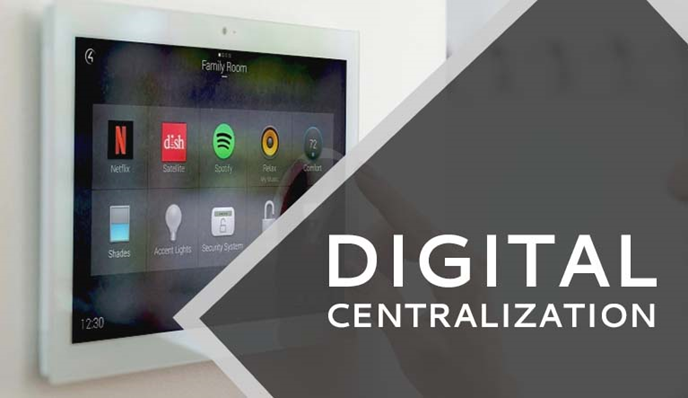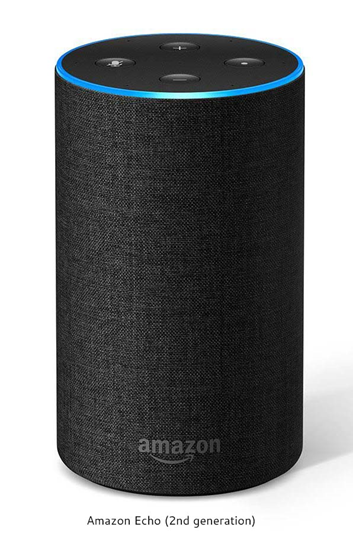
We live in a world full of smart digital devices, where these devices have a great impact on our day to day life. When a digital device is getting smarter, it will be capable of performed certain functions based on the commands sent by users. Some devices also capable of operating autonomously to help in the daily activities of users. These devices do not only interact with users but also with other smart devices. Smart devices show some characteristics of ubiquitous computing including context awareness which allows devices to collect information about its environment and optimize the operations, devices are networked and distributed, etc. Since all these smart devices are internet-enabled, it can interconnect the multiple devices and then, one device can access the features of other devices.
Digital centralization is the process of connecting all available devices in order to access the functionalities of each device. This technology allows an effective way to establish proper communication between devices. The demand for a concept like digital centralization is increased as millions of smart devices flow into the market. Because, when the device count increases, users face some difficulties to handle them. Digital centralization creates the seamless connection between devices which leads to a smarter living environment while reducing the number of devices being used. When it comes to smart devices, smartphones are the most popular and widely used smart devices. It can be used to perform a number of functionalities including check and replying emails, conduct online conferences, sending SMS, view CCTV streaming, schedule important events, and meetings, etc. Without the smartphone, it’s obvious that users require to access many devices to perform those functions. Also, digital centralization makes it possible to perform these types of multiple tasks from a single central location.
Smart speaker
Smart speakers can be identified as one of the prime examples for digital centralization. The smart speaker act as a centralized hub which connects with all the smart home devices and allows to activate the functions of smart home devices through voice instructions. Therefore, a centralized approach of smart speakers plays a huge role in home automation. Apple HomePod, Amazon Echo and Google Home are some of the most popular smart speakers in the market. These speakers run on the technology called voice recognition. The key role of any smart speaker is to recognize the user’s voice instructions and responds to them accordingly. The smart speaker always keeps listening to the voices around it and wait for the wake-up word to activate the system.
For instance, Alexa is Amazon’s digital voice assistant and system will trigger after hearing the wake word “Alexa”. Then, smart speakers start to record the instructions followed by that wake word and send them to Amazon’s AVS (Alexa Voice Services). AVS processes the instructions and sends the response back to the smart speaker. Typically smart speakers respond to the user instructions by playing your favorite music, answering to the queries such as weather forecast, traffics, date and time, etc. It is also possible to integrate many smart home devices to the smart speaker in order to create a smart home environment. Popular features of home automation may include change the temperature of thermostat, control security systems, turn on TVs, lock doors, lighting control, etc.

Regardless of the size of the organization, this technology can be applied to the organization operations too. Nowadays data generates more than ever because of the circulation of millions of internet-enabled smart devices. Many organizations use smart devices to streamline their business processes and to provide effective service to their customers. By adopting the digital centralization as an IT strategy, organizations are able to manipulate the corporate data more efficient manner. IT systems which belong to the different departments can be integrated through digital centralization and by that, it will help to make better and faster management decisions. BYOD policy allows employees to bring their own devices to the workplace and this approach has led many organizations to adopt the digital centralization. When the data stored in a centralized location, administrators have greater control over data and with smart devices, employees are able to access the data from any location. Even smaller-scale businesses can well-coordinate their business processes through this technology to perform better in the future. This technological shift creates smart workplaces, where employees also benefited from facilities such as working from home etc.
Let’s try to understand how digital centralization concept can adapt to the hotel industry.
- After a guest arrives at the hotel, the check-in process can be done completely using a smart tablet. If the guest did an online booking before, he has to fill a few more details to complete the hotel check-in process.
- If the guest arrives on a hot day, the hotelier can turn on the air condition unit of the guest’s room while the guest is involving in the check-in process.
- Guests are able to order foods and beverages through a digital menu from any location including their room, restaurant or poolside bar, etc.
- Also, they can request some room services. Since every digital device is connected to a centralized database, simultaneously the guest’s account will update with new entries.
- At the check-out counter, guests can view his expenses during the stay and settle the bill using an online payment method.
Benefits of Digital Centralization
- In digital centralization, all users dealing with the data which store in one centralized location. Therefore, they could easily either retrieve data from it or add new data to the system.
- The centralized approach reduces the data redundancy which leads to saving more data storage space and by that, it will lessen the storage cost.
- By adopting digital centralization, organizations are standardized their workflow and structure, as a result, it will increase the transparency of organizational operations.
- Since the data is stored in a single centralized location, users are able to immediately access the accurate and up to date information.
- As an innovative technological trend, digital centralization streamlines the operations of organizations and improves the living standards of people.


